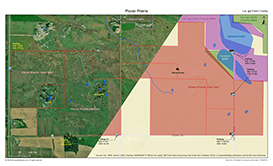Plover Prairie
East Unit
About • Location • Activities • Ecology
About |
||
Ownership |
||
|
||
Links |
||
Overview |
||
|
||
History |
||
In October 1985 The Nature Conservancy (TNC) purchased 160 acres of land in northern Lac qui Parle County and designated it Plover Prairie Preserve. In 1986 it added 275 acres adjacent to the original tract. in 1989, it purchased a nearby but non-adjacent 140-acre tract, and this became the West Unit of Plover Prairie. In 1990, 80 acres were added to the East Unit. In 2003, TNC secured an easement on a 240-acre parcel that connects the two units. In 2012, the TNC purchased that parcel. It is treated separately on the TNC Website as Plover Prairie Addition Preserve. |
||
Management |
||
|
||
Comments |
||
|
||
Driving Directions |
 |
|||||
| Lac qui Parle County | ||||||
| Southwest Minnesota | ||||||
Activities |
||
Hiking Trails |
||
No maintained trails |
||
Hunting |
||
No hunting |
||
Ecology |
|||||||
Ecological Classification |
 |
||||||
| Ecological Province | Prairie Parkland Province |
||||||
| Ecological Section | North Central Glaciated Plains |
||||||
| Ecological Subsection | Minnesota River Prairie |
||||||
| Land Type Association | Milan Alluvial Plain |
||||||
Native Plant Communities* |
|||||||
Mesic Prairie (Southern) |
|||||||
| * Source: The Minnesota Biological Survey, Minnesota Department of Natural Resources, Division of Ecological Resources | |||||||
Natural Features |
|||||||
|
|||||||

Slideshows |
||

Visitor Videos |
|||
Share your video of this destination. |
|||
| This button not working for you? Simply email us at info@MinnesotaSeasons.com. Attach a video, a YouTube link, or a cloud storage link. |
|||
Other Videos |
|||


Created: Last Updated: © MinnesotaSeasons.com. All rights reserved. |







































